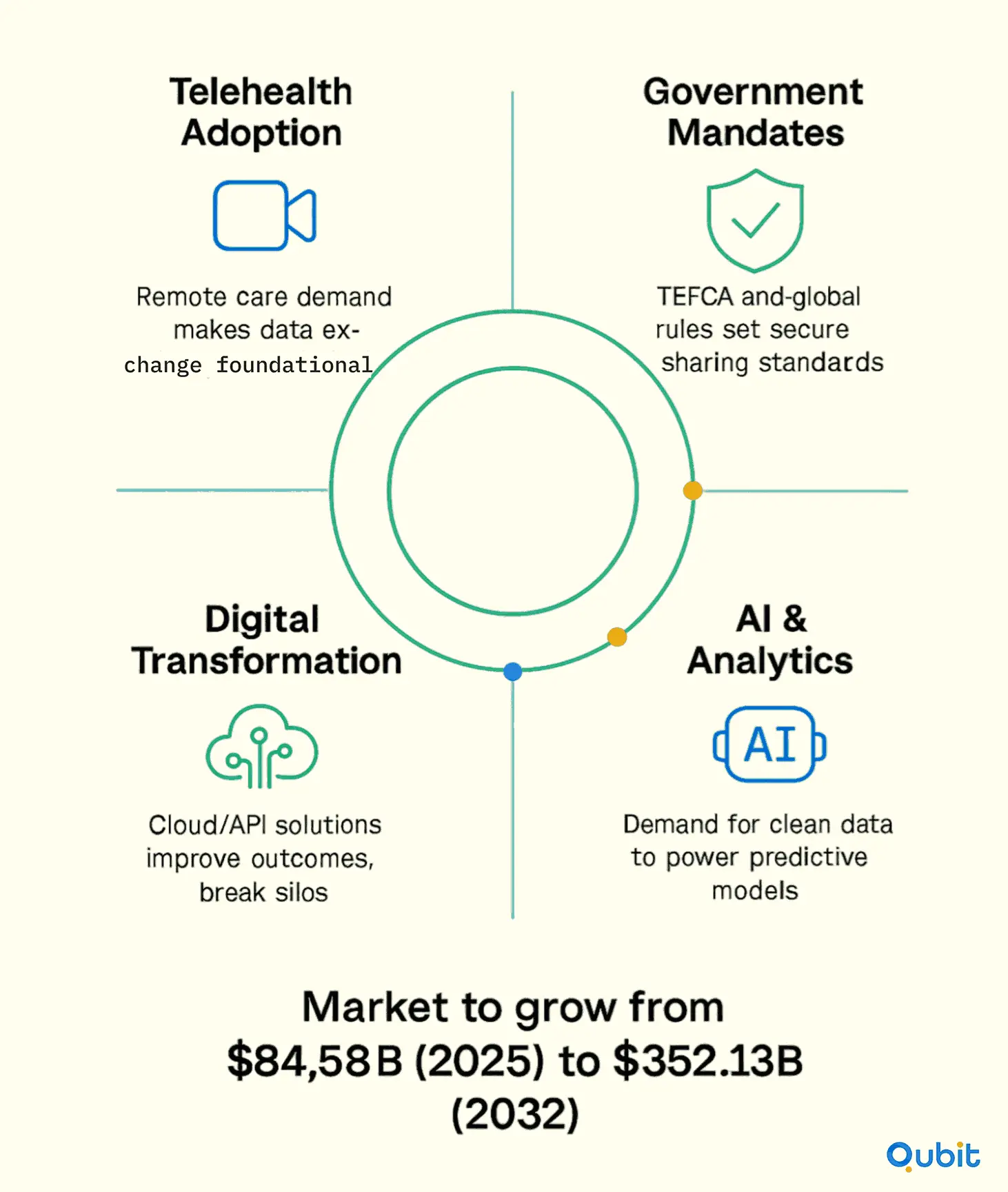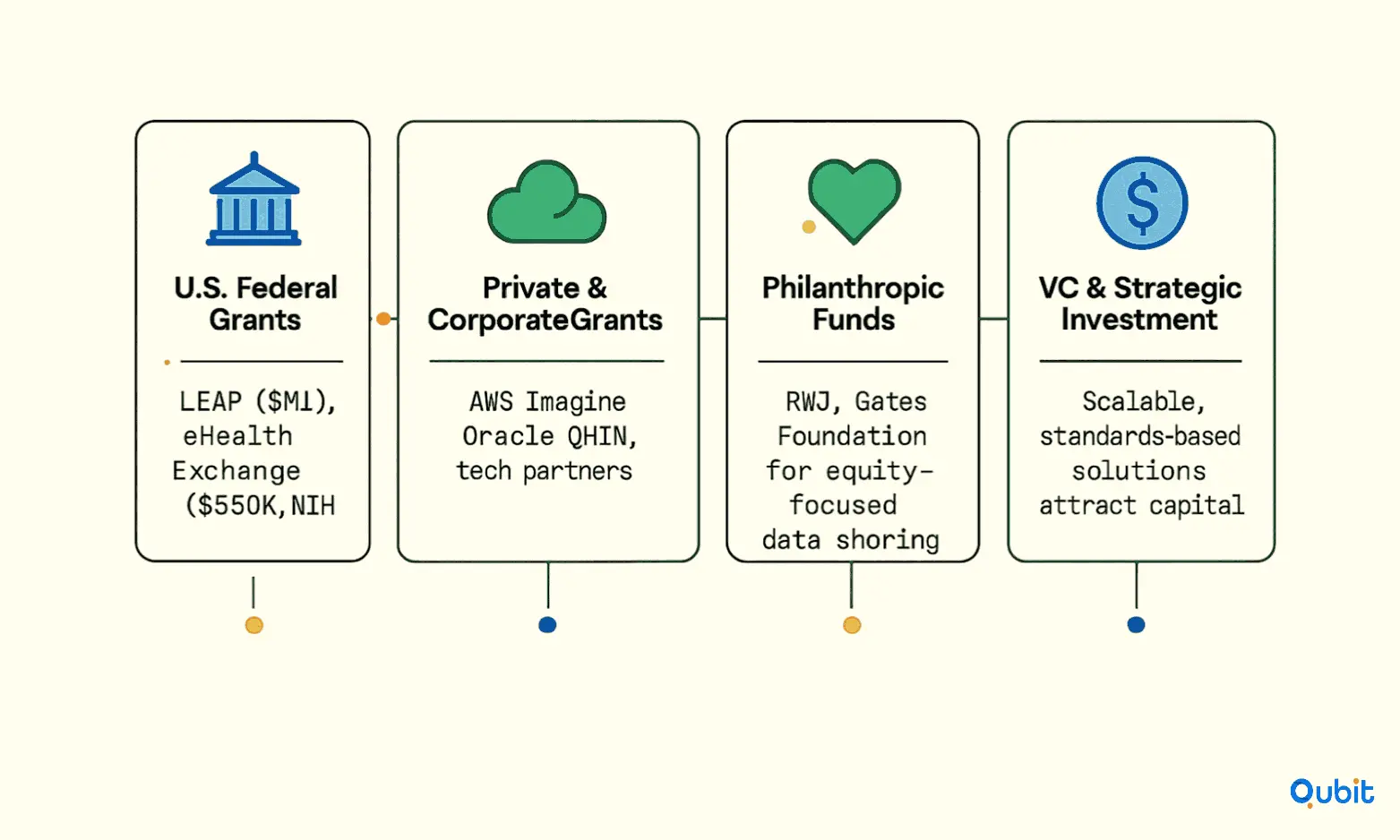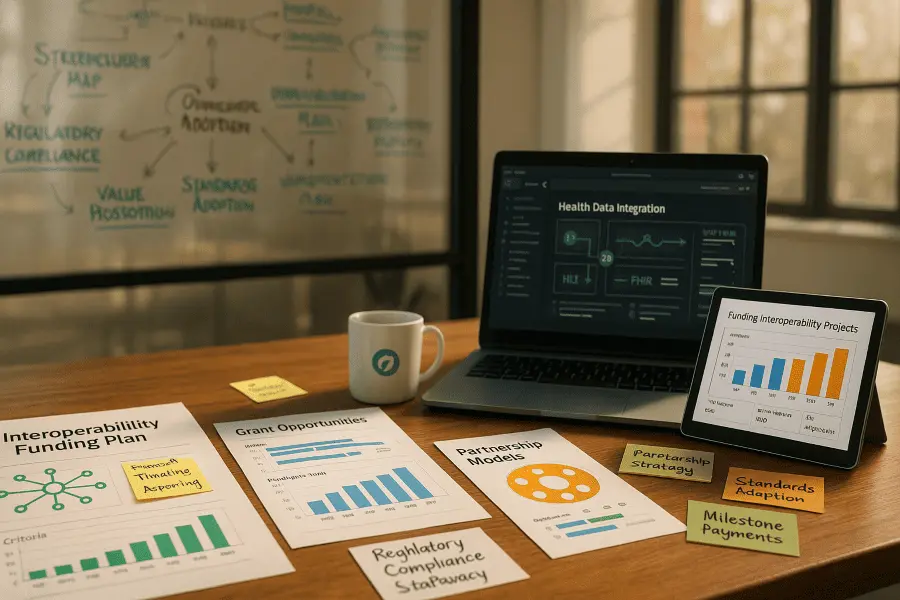Health-data interoperability has become a cornerstone of digital health transformation, enabling seamless, secure, and real-time data exchange across healthcare systems, providers, and patients. As the healthcare sector accelerates its shift toward value-based care, telehealth, and AI-driven analytics, the need for robust interoperability solutions is more urgent, and more lucrative, than ever. For founders and innovators, understanding the funding landscape is key to scaling solutions that can meet this demand.
This article explores the current market opportunity, the economic and clinical case for interoperability, and the major funding avenues, public and private, available to startups and organizations building the next generation of interoperable health data platforms.
The Market Opportunity: Health-Data Interoperability in 2025 and Beyond
The global health data interoperability market is projected to reach $84.58 billion in 2025 and soar to $352.13 billion by 2032. This explosive growth is fueled by several converging trends:

- Telehealth adoption: The pandemic has permanently shifted patient and provider expectations toward remote care, making seamless data exchange foundational for telehealth platforms.
- Government mandates: Regulatory frameworks such as the Trusted Exchange Framework and Common Agreement (TEFCA) in the U.S. and similar initiatives worldwide are setting new standards for secure, nationwide health data sharing.
- AI and analytics: The proliferation of AI in healthcare is driving demand for interoperable, high-quality data to power predictive models and real-time clinical decision support.
- Digital transformation: Hospitals, payers, and life sciences companies are investing in cloud-based, API-driven solutions to break down silos and improve patient outcomes.
Economic Impact
The financial case for interoperability is compelling: full interoperability could save the U.S. healthcare system $77.8 billion annually by reducing administrative costs, duplicate testing, and medical errors, while improving care coordination and population health. Administrative cost savings alone could reach 60-70% through automation and standards-based data sharing.
Why Interoperability Matters: Clinical and Economic Benefits
- Clinical efficiency: Physicians currently spend an average of 16 minutes per patient encounter searching for external health records. Interoperability could reduce this to just 3–4 minutes, freeing up time for patient care.
- Reduced errors: Medical errors, often caused by incomplete information, cost the U.S. system up to $29 billion annually. Interoperable records could prevent up to 30% of these errors.
- Patient-centered care: Seamless data exchange enables coordinated, holistic care—especially critical for chronic disease management, remote patient monitoring, and transitions between care settings.
- Innovation: Interoperability is the backbone for digital health innovation, supporting everything from AI-powered diagnostics to population health analytics and personalized medicine.
Funding Landscape: Public and Private Opportunities

1. U.S. Federal Grants and Programs
Leading Edge Acceleration Projects (LEAP) in Health IT
The U.S. Office of the National Coordinator for Health Information Technology (ONC) funds the LEAP in Health IT program, supporting projects that address emerging challenges in health IT interoperability. For fiscal year 2025, LEAP is offering up to $1 million per award for projects focused on:
- Demonstrating readiness of FHIR®-based subscriptions for improved interactivity with third-party apps.
- Testing innovative approaches to enhance TEFCA infrastructure and increase adoption of Individual Access Services (IAS).
Applicants must demonstrate technical expertise in HL7® FHIR® and propose scalable, standards-based solutions. The program is open to a wide range of organizations, including startups, academic centers, and consortia.
EHealth Exchange Innovation Grants
The eHealth Exchange, a major U.S. health information network, has launched an Innovation Grant program offering up to $550,000 for projects that boost electronic health information exchange or develop new technical connectivity tools. Proposals leveraging HL7 FHIR or other interoperability standards are encouraged, and multi-organizational applications are welcome.
Other Federal Funding
- National Institutes of Health (NIH): Funds research on data integration, interoperability, and digital health.
- Centers for Medicare & Medicaid Services (CMS): Offers grants and pilot funding for interoperability and care coordination initiatives.
- Agency for Healthcare Research and Quality (AHRQ): Supports research on health IT and patient safety.
Securing capital in healthcare can feel like running a clinical trial, How to Secure Funding for Healthcare Startups: A Step-by-Step Guide. demystifies each phase from pitch deck to term sheet.
2. Private Sector and Corporate Grants
Tech Giants and Cloud Providers
Major technology companies are investing in interoperability through grants, partnerships, and accelerator programs:
- Oracle Health is applying for Qualified Health Information Network (QHIN) status under TEFCA, aiming to simplify secure data exchange using Oracle Cloud Infrastructure.
- Amazon Web Services (AWS) offers the IMAGINE Grant to advance data exchange in health and social care, supporting projects that leverage cloud-based interoperability and digital health innovation.
Healthcare Industry Consortia
- CommonWell Health Alliance, Carequality, and DirectTrust: These industry groups often fund pilot projects and provide technical support for startups working on interoperability solutions.
Philanthropic and Impact Funds
- Robert Wood Johnson Foundation, Gates Foundation, and others: These organizations fund projects that advance health equity through better data sharing and digital infrastructure.
Digital health is rewriting patient care, How Digital Health Technology Is Driving Healthcare Investments highlights the breakthroughs that have investors lining up.
Venture Capital and Strategic Investment
As the market for health-data interoperability grows, venture capital and strategic investors are increasingly active:
- AI in Healthcare: Investors are backing startups that use interoperable data for AI-driven analytics, clinical decision support, and population health. From diagnostic AI to virtual nursing, AI in Healthcare: Current Investment Trends dives into where smart money is flowing right now.
- Telehealth and Remote Monitoring: Companies enabling seamless data exchange between telehealth platforms, EHRs, and remote patient monitoring devices are attracting significant capital.
- Digital Health Startups: Early-stage startups with scalable, standards-based interoperability solutions are prime targets for VC and corporate investment.
What Funders Want: Key Criteria for Interoperability Projects
To succeed in securing funding, startups and innovators should focus on:
- Standards-based solutions: Use widely adopted protocols like HL7 FHIR, APIs, and cloud-native architectures.
- Scalability: Demonstrate that your solution can work across multiple health systems, geographies, and data types.
- Security and compliance: Address data privacy, HIPAA, and other regulatory requirements from the outset.
- Demonstrable impact: Show how your solution reduces costs, improves outcomes, or enables new models of care.
- Collaborative approach: Funders often favor multi-stakeholder projects involving providers, payers, tech partners, and patients.
Market Challenges and Innovation Frontiers
While the growth outlook is strong, challenges remain:
- Data security and privacy: As interoperability expands, so do risks of breaches and misuse. Solutions must prioritize end-to-end encryption, consent management, and regulatory compliance.
- Implementation complexity: Integrating disparate EHRs and legacy systems is costly and technically demanding, especially for smaller providers.
- Standardization gaps: Despite progress, differences in data formats and exchange protocols can hinder seamless interoperability.
- Cost and ROI: High upfront costs and uncertain returns can make funders cautious. Demonstrating clear, near-term value is essential.
Innovation is advancing on several fronts:
- Blockchain and decentralized data sharing: Offering new models for secure, patient-controlled data exchange.
- API marketplaces and plug-and-play solutions: Lowering barriers for integration and customization.
- AI-enabled analytics: Unlocking new insights from interoperable data, from predictive risk scoring to personalized treatment pathways.
How to Position Your Startup for Funding
- Map the opportunity: Quantify the market need and potential impact of your solution.
- Build partnerships: Collaborate with health systems, payers, and tech companies to pilot and validate your approach.
- Leverage pilot funding: Apply for grants and innovation challenges to de-risk your technology and demonstrate traction.
- Showcase compliance: Make data privacy, security, and regulatory alignment central to your pitch.
- Highlight scalability: Use case studies or pilots to show how your solution can expand across settings and regions.
Case Studies: Funding in Action
- Oracle Health’s QHIN Initiative: By aligning with TEFCA and leveraging cloud infrastructure, Oracle Health is positioning itself as a leader in secure, nationwide data exchange.
- eHealth Exchange Innovation Grants: Non-profits and startups have used these grants to build new FHIR-based tools and expand connectivity across networks.
- LEAP in Health IT Awardees: Past recipients have piloted real-time data sharing apps, advanced FHIR adoption, and tested new consent management frameworks.
The Road Ahead: Trends and Outlook
- Market growth: The healthcare interoperability solutions market is expected to grow at a CAGR of 14.5% between 2025 and 2035, reaching $24.8 billion by 2035.
- Policy momentum: Regulatory trends in 2025 and beyond will continue to drive interoperability, with new rules on payer data exchange, patient access, and cross-border health data sharing.
- Digital transformation: Investments in cloud, AI, and API-based platforms will accelerate, enabling new models of care and research.
- Equity and access: Funders are increasingly focused on solutions that improve health equity, rural access, and patient empowerment through better data sharing.
Conclusion
Health-data interoperability is no longer just a technical challenge, it’s a strategic imperative for the future of healthcare. With government mandates, digital transformation, and AI adoption all fueling demand, now is the time for visionary founders to seize the moment. By building strong collaborations and focusing on measurable value, you can position your company at the forefront of healthcare’s interoperable future.
If you’re ready to explore fundraising assistance services. Qubit Capital’s funding experts are here to guide you through this dynamic environment and accelerate your journey toward interoperability-driven innovation.
Key Takeaways
- The global health-data interoperability market will exceed $84 billion in 2025, driven by telehealth, AI, and regulatory mandates.
- Achieving full interoperability could save the U.S. healthcare system nearly $78 billion annually in administrative and clinical efficiencies.
- Major funding sources include federal grants (LEAP, eHealth Exchange), tech industry grants, venture capital, and philanthropic funds.
- Funders seek standards-based, scalable, secure, and impact-driven solutions with strong compliance and collaborative models.
- Innovation in blockchain, AI, and API-based platforms is lowering barriers and accelerating adoption across healthcare.
- Demonstrating real-world impact, regulatory alignment, and scalability is essential for attracting funding in this fast-growing sector.
Frequently asked Questions
What is health-data interoperability?
It’s the ability of different health IT systems and software to exchange, interpret, and use data seamlessly and securely.


 Back
Back



